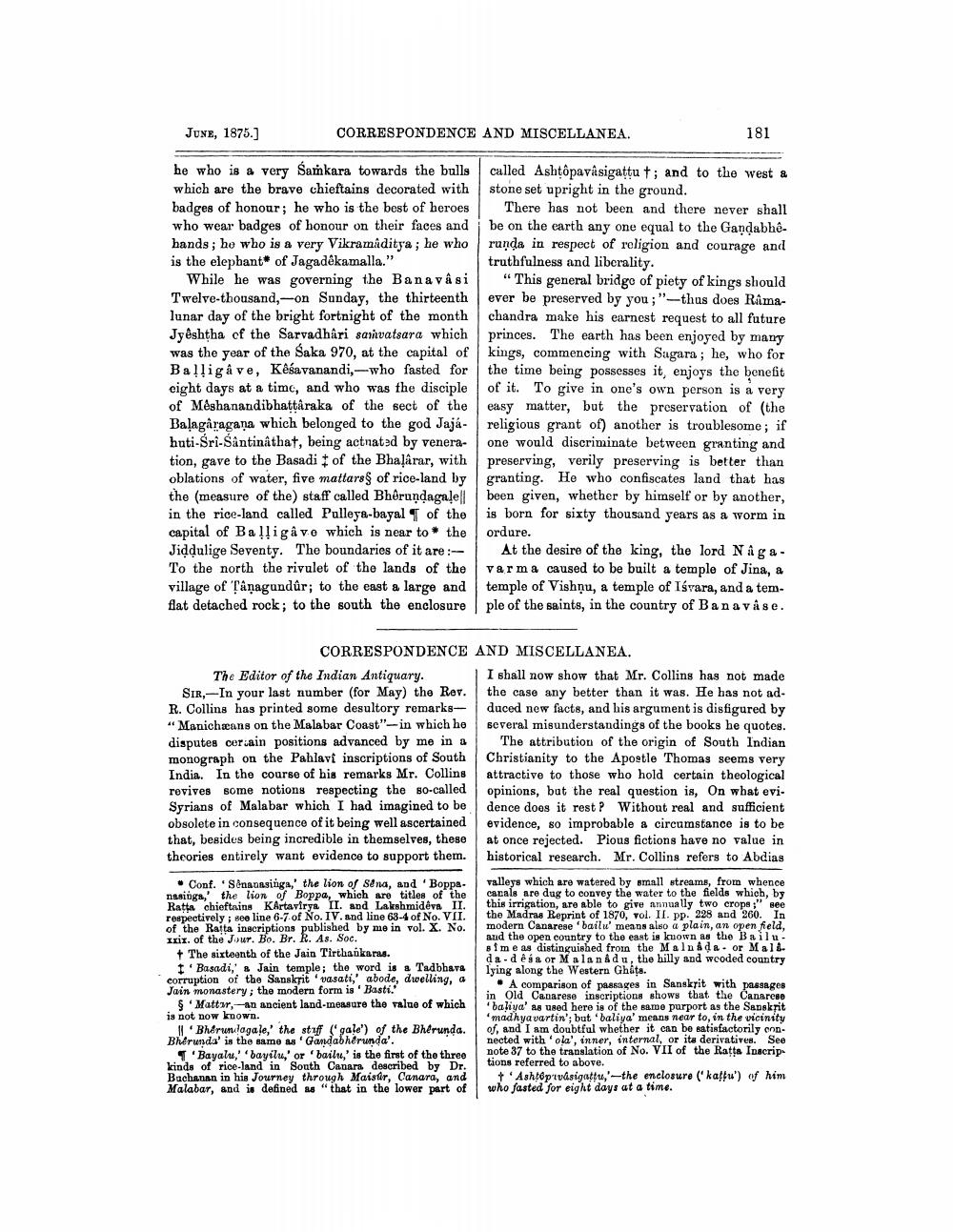________________
JUNE, 1875.]
CORRESPONDENCE AND MISCELLANEA.
181
he who is a very Sarkara towards the bulls called Ashtôpavasigattu t; and to the west & which are the brave chieftains decorated with stone set upright in the ground. badges of honour; he who is the best of heroes There has not been and there never shall who wear badges of honour on their faces and be on the earth any one equal to the Gandabhê. hands; he who is a very Vikramaditya; he who runda in respect of religion and courage and is the elephant* of Jagadêkamalla."
truthfulness and liberality. While he was governing the Banava si "This general bridge of piety of kings should Twelve-thousand, -on Sunday, the thirteenth ever be preserved by you ;"-thus does Ramalunar day of the bright fortnight of the month | chandra make his earnest request to all future Jyêshtha of the Sarvadhari samvatsara which princes. The earth has been enjoyed by many was the year of the Saka 970, at the capital of kings, commencing with Sagara; he, who for Balliga ve, Kéśavanandi,-who fasted for the time being possesses it, enjoys the benefit cight days at a time, and who was the disciple of it. To give in one's own person is a very of Mêshanandibhattâraka of the sect of the easy matter, but the preservation of the Balagåragana which belonged to the god Jajá- religious grant of) another is troublesome; if huti-Sri-Sântinâthat, being actnated by venera- one would discriminate between granting and tion, gave to the Basadi I of the Bhaļärar, with preserving, verily preserving is better than oblations of water, five mattars of rice-land by granting. He who confiscates land that has the (measure of the staff called Bhorundagnlell been given, whether by himself or by another, in the rice-land called Pulleya-bayal of the is born for sixty thousand years as a worm in capital of Balligå vo which is near to the ordure. Jiddulige Seventy. The boundaries of it are:- At the desire of the king, the lord Naga. To the north the rivulet of the lands of the varma caused to be built a temple of Jina, a village of Panagundûr; to the east a large and temple of Vishnu, a temple of Isvara, and a temflat detached rock; to the south the enclosure ple of the saints, in the country of Banavåse.
CORRESPONDENCE AND MISCELLANEA. The Editor of the Indian Antiquary. I shall now show that Mr. Collins has not made SiR.-In your last number (for May) the Rev. the case any better than it was. He has not ad. R. Collins has printed some desultory remarks- duced new facts, and his argument is disfigured by " Manichæans on the Malabar Coast"-in which he several misunderstandings of the books he quotes. disputes corain positions advanced by me in a The attribution of the origin of South Indian monograph on the Pahlavi inscriptions of South Christianity to the Apostle Thomas seems very India. In the course of his remarks Mr. Collins attractive to those who hold certain theological revives some notions respecting the so-called opinions, but the real question is, On what evi. Syrians of Malabar which I had imagined to be dence does it rest? Without real and sufficient obsolete in consequence of it being well ascertained evidence, so improbable a circumstance is to be that, besides being incredible in themselves, these at once rejected. Pious fictions have no value in theories entirely want evidence to support them. historical research. Mr. Collins refers to Abdias
• Conf. Sênanasinga,' the lion of sana, and 'Boppanasinga,' the lion of Boppa, which are titles of the Ratta chieftains KArtavirya II. and Lakshmidêva II. respectively; see line 6-7 of No. IV. and line 68-4 of No.VII. of the Ratta inscriptions published by me in vol. X. No. Ixix. of the Jour. Bo. Br. R. As. Soc.
+ The sixteenth of the Jain Tirthaikara.
I. Basadi, & Jain temple; the word is a Tadbhava corruption of the Sanskrit 'vasati,' abode, dwelling, a Jain monastery; the modern form is 'Basti.
$Mattor,-an ancient land-measure the value of which is not now known.
Il Bherundlagale,' the stiff gale") of the Bherunda. Bherunda' is the same as 'Gandabherunda'.
Bayalu,''bayilu,' or 'bailu,' is the first of the three kinds of rice-land in South Canara described by Dr. Bachanan in his Journey through Maisur, Canara, and Malabar, and is defined as "that in the lower part of
valleys which are watered by small streams, from whence cacals are dug to convey the water to the fields which, by this irrigation, are able to give annually two crope;" see the Madras Reprint of 1870, vol. II. pp. 228 and 260. In modern Canarese "bailu' means also a plain, an open field, and the open country to the east is known as the Bailu. sim e as distinguished from the Malnada. or Mall da-dega or Mala n&du, the hilly and wooded country lying along the Western Ghats.
• A comparison of passages in Sanskrit with passages in Old Canarese inscriptions shows that the Canarese baliya' as used here is of the same purport as the Sanskrit madhya vartin'; but baliya' means near to, in the vicinity of, and I am doubtful whether it can be satisfactorily connected with ola', inner, internal, or ita derivatives. See note 37 to the translation of No. VII of the Ratta Inscrip tions referred to above.
Ashtoprvúsigattu,'--the enclosure ('kattu) of him who fasted for eight days at a time.




